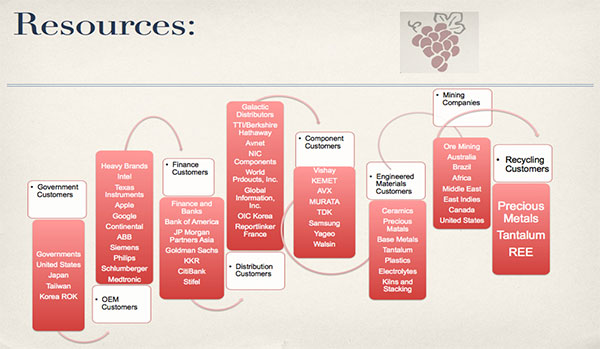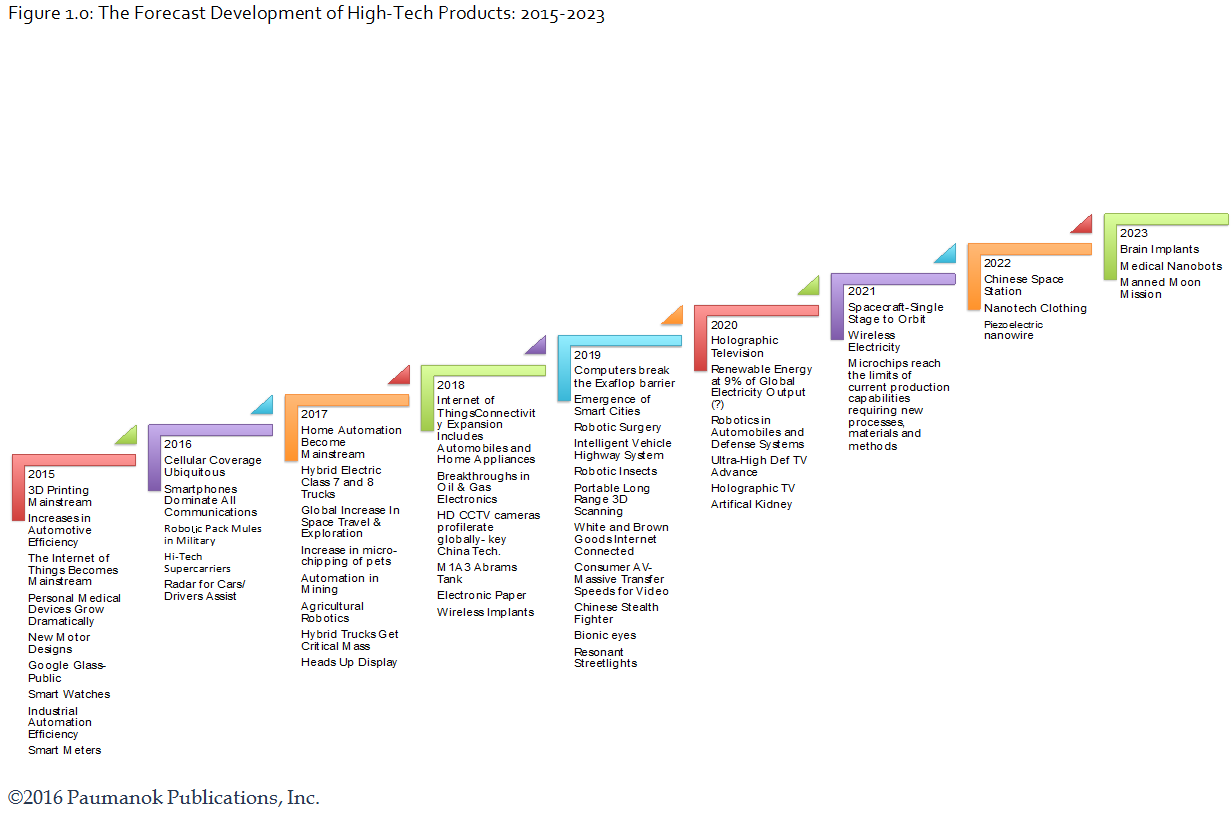The Purpose of this MarketEYE Article
As a result of the ubiquitous nature of passive electronic components, and the great maxim that all electrical and electronic devices require some degree of capacitance, resistance or inductance to operate, I am continually exposed to a myriad of end-markets, each of which is crowded with dreamers who hope to innovate better products for the future—who are trying to roadmap how their customers will embrace the new and improved products they plan on developing over the next ten years.
I have collected and disseminated this data through 30 years of focused advanced research as the founder and director of research at Paumanok IMR, and will attempt to create a novel picture of the future at hand, and to emphasize the innovators, large and small, that are at the leading edge of where the past makes way for the future. Paumanok is known for its advanced research methodology and deep knowledge of data sources around the globe.
My Safe Harbor Statement
Almost every major brand company in the world encourages forward-thinking creativity, and many of the ideas that result from such endeavors are truly revolutionary but never make it out of the planning stage because the corporation determines the return on investment will not justify the initial expense; while other ideas grow at such a rapid pace that legislators cannot act quickly enough to provide adequate regulations and control. So while this article is designed to offer some guidelines for the future, it is by no means a guarantee that such developments will come to fruition.
Overview
The following is a collection of expected areas of growth in the high-tech economy between 2015 and 2023 and the manufacturers who are endeavoring to innovate for the future.
Smartphones
Cellular coverage is almost ubiquitous, which has helped triple product penetration by global population in 2005. Smartphones will continue to displace older model phones, keeping component demand high over the next five years. The rate of return will slow as the churn rate reaches levels that executives at Nokia used to fantasize about and the rest of the high-tech engineering community could only believe was hyperbole. In 2020, Smartphones will have the computing power of personal computers operating today. The introduction of low-cost individual sensor technology will have the capability to communicate with handsets. Therefore, the continued miniaturization of electronic components will be necessary to achieve the grand vision of volumetric efficiency of the future. Component process technologies will shift to accommodate the roadmap, as will electronic materials. The future design engineers will have to broaden their palettes, and feel more comfortable dancing about the periodic table.
The Internet of Things
“The Internet of Things” is a phrase coined by British technology pioneer Kevin Ashton who co-founded the Auto-ID Center at the Massachusetts Institute of Technology (MIT). The term describes a system where the Internet is connected to the physical world via ubiquitous sensors. It is now estimated by at least one brand name company whose forecasts have been directionally correct that by 2020 as many as 50 billion devices of all types, shapes and sizes will be wirelessly connected to the internet. From a component perspective, the key words are connected and sensor; and once again from a materials perspective, we see ceramacists peering over the fence into the netherworld of mixed metal oxides.
According to another brand name based wireless infrastructure and backbone vendor based in California, mobile data transmission volumes will increase 1,000 times over the next 10 years, and the wireless industry will increase the number of antennas proportionately in handsets and inside buildings; access new parts of the wireless spectrum; and improve the signal-to-noise ratio of data transmissions. This also bodes well for thin film platforms in passive components and added materials expertise.
Wearable Technology
The smart watch has great potential for electronic component consumption, because it has a myriad of functions and in many ways resembles the component circuitry of the smartphone, which now offers GPS, calculator, radio, compass, calendar, thermometer and related functions in a compact, sleek wristwatch design. Paumanok believes that there is a real opportunity for success in wearable technology at the extreme edge of fitness and fashion.
Sensor technology is inexpensive and extremely small and robust and will continue to find advanced opportunities in flight suits; which are expected to eventually manifest itself commercially in racing suits and in adventure sports.
Personal Medical Devices
The technology has developed from the initial success of low-tech wearable technology such as pedometers, heart rate monitors and smart scales and the high-tech success of implantable cardio defibrillators that can store heart related data, which can be downloaded in a doctor’s office. Advanced personal medical devices are expected to resonate with the self-reliant who wish to have greater control over their medical care through the advent of “digital health.” Advanced medical devices can offer the wearer access to personal EKG (electrocardiogram) monitors, glucose measuring devices and blood pressure monitors; and with the further adoption of the “internet of things” will also be able to transmit the collected data to their primary care physician without having to visit the doctor’s office.
Additive Manufacturing
Additive manufacturing, which is known in the popular media as 3-D printing, is one of the most exciting and far reaching developments to impact global industrial manufacturing platforms in the past quarter century. Additive manufacturing is the process of building a three dimensional object by spraying ceramics or metals along with liquid binder materials. The process can create new inexpensive prototypes or be used for mass production of new inventions. The 3D printer itself is of great interest, and can be described as robotic in nature, and under computer control.
The grand theory is that domestic 3D printers of the future will enable consumers to avoid costs associated with purchasing common household objects. Instead they can simply manufacture them in-house and on demand. Currently, 3D printers have been sold into a broad spectrum of industrial end-use markets for prototyping, including the automotive industry, the dental and medical industries; the aerospace industry, the defense industry, the fashion industry, the footwear industry, the architectural industry and the construction industry.
Renewable Energy
Solar, wind, geothermal and ocean wave sources of renewable energy accounted for an estimated 6% of global power generation capabilities in 2015 and is forecast to rise to 9% by 2020 (A 60% increase).
The great benefactors of this increase will be wind power generation and solar farms, although ocean wave technology also seems quite promising because it is not intermittent. The electronics associated with the transference of wind and solar energy into stored electrical energy requires a variety of electronic components.
Oil and Gas Electronics
The true benefit of the development of renewable energy sources is a lower reliance upon fossil fuels, namely oil and gas, to produce the majority of electricity consumed in the world. The theory is that through manipulation of government backed subsidies – giving more to the renewable sector and less to the fossil fuel sector will cause a dynamic shift in how power is generated on a global scale. But even the best forecasts still suggest that fossil fuel demand will grow between 2015 and 2020, probably at a combined rate of 7%. To address growing demand for oil and gas, vendors have become innovative in how they drill for and access vast pockets of underground wealth, relying more heavily on specialty electronic sensors and logging tools to make sure that nothing is missed and all wells are fully vetted. Electronic components consumed in these applications must withstand tremendous heat, pressure, shock and vibration and must be robust for harsh environments.
This is also a slingshot market. The excess capacity in the pipeline has idled platforms and rigs globally. The general agreement is that oil is finite and this market will come roaring back over the next five years (CHB presentations in the oil and gas drilling segment are expecting a 2017 turnaround but are quick to announce they are uncertain and the situation remains volatile).
Home Automation
Revenues derived from sales of home automation have been growing substantially since 2009 and this trend is expected to gain momentum through 2020. Home automation includes the centralized control of entertainment, lighting, heating, ventilation and air conditioning, home appliances, and security systems; as well as the dispersion of touch panel controls throughout the residence, and additional remote controls through tablets and smartphones. It is believed that the “Internet of Things” mentioned above will have a major impact on accelerating growth in home automation systems. To date, the majority of “smart homes” are multi-million dollar residences newly constructed or under renovation and located in upscale urban environments or luxury seaside or country retreats. However, the continued proliferation of low cost technology and the expected simplicity of management of home automation systems over time suggest they will be available for the masses in the near term.
Advanced Television
The concept of advanced television permeating the home is well underway; beginning with the movement from cathode ray tube monitors to flat panel displays, and then the introduction, adoption and transference from analog to digital signals, which is well underway in most parts of the world. The next successful step in the adoption of advanced television was in “time-shifting” which placed greater control in the hands of the viewer and allowed, through the augmentation of television with the digital video recorder, for the viewer to control when it reviewed content. The next logical step will be the interoperability of the best functions of computing and video imaging in multiple appliances.
This concept fits nicely with advanced “home automation” and the “internet of things” and suggests further developments involving “electronics ready architectural glass displays” that will augment mirrors, refrigerator doors and physical desktops with high definition displays that offer the best of television, the internet and word processing capabilities seamlessly between devices. It is believed that the concept of architectural glass displays will also find applications in the ‘smart cities” of the future, and be employed in transportation and control signage and signaling, advertising billboards and bus stop walls.
The long-term capabilities of advanced television also suggest the possibility of holographic television being available in 10 to 15 years. The development of the spatial light modulator chip at the Massachusetts Institute of Technology is the catalyst for holographic television. The chip can create a display of 50 or more giga-pixels per second and bend light in multiple directions.
Automotive Electronics
The “electronification” of the automobile will continue to 2020, and this will include various levels of hybridization- mild to full- although the full penetration rates of hybrids is difficult to gage, simply because there is a direct correlation between fossil fuel prices and increases in hybrid electric vehicle sales. In the short term, the development of smaller, lighter automobiles, with start/stop technology, fuel efficient tires, small quantity cylinders with turbo charged boost power, will certainly increase fuel efficiency to the 30 mile per gallon range for a price that is less than $20,000 USD (cars such as the KIA Soul, the Ford Fiesta and the Mazda 3) which seems like the right combination for growth. In fact future concept vehicles introduced by Nissan for example seem to have greater focus on multiple avenues of efficiency that combine robotics and advanced computing with transportation.
Additional Developments
There will be many additional developments over the next seven years, with great expectations for electronic systems over the long term. In addition to the main points emphasized above, there will be an increase in the commercialization of space (with space tourism at the forefront), coupled with the increased attempt at the dominance of the government backed Asian space race between China, India and Japan, which will result in additional space stations and probes as well as an expected manned flight to the moon; and the development of single stage to orbit rockets. In computing there will be a greater emphasis on implementing multi-core processing and DDR4 memory. In lighting there will be greater emphasis upon Light Emitting Diodes, which will also lead to fiber optic lighting of the future. Robotics will play a greater role, not only in automotive markets, but in defense and medical environments as well. Motors will evolve and become more efficient, and a variety of new and exciting electronic components will be developed to support new electronic platforms – from memristors to piezoelectric nanowire – the future of electronics is bright.

Statements of fact and or opinions expressed in MarketEYE by its contributors are the responsibility of the authors alone and do not imply an opinion of the officers or the representatives of TTI, Inc.


